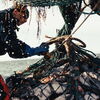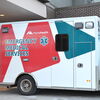Processing Your Payment
Please do not leave this page until complete. This can take a few moments.
Outdoor training grounds: Pilot program at Acadia aims to improve science literacy in schools
Acadia National Park is often cited for its natural beauty, but a new initiative would use the park as a learning lab where teachers and students of all ages can acquire key skills to apply to STEM disciplines and ultimately, turn that knowledge into better-paying jobs and know-how to protect the environment.
Called Second Century Stewardship, IDEXX Laboratories Inc. founder and Black Point Group investor David Shaw came up with the initiative last year during the centennial celebration of the National Park Service. Shaw pledged $1 million to kick off collaborative programs between the park service, Schoodic Institute at Acadia National Park, the American Association for the Advancement of Science and other institutions. The goal, Shaw says, is to eventually use the Acadia pilot program at other national parks both for public education and environmental stewardship, especially within the parks.
“This would leverage national parks to advance science education,” he says.
Another $9 million needs to be raised from private sources and foundations to fully fund the program, adds Mark Berry, CEO and president of the Schoodic Institute, which is based in Winter Harbor. “We'd like to get to $10 million to endow the partnership in Maine,” he says.
Both Acadia and Schoodic also have their own education programs that they fund separately, some of which will collaborate with Second Century.
Currently, Second Century is sponsoring research by postdoctoral fellows, part of whose grant requires them to help develop the science curricula for local elementary through high schools.
In the summer of 2018, the program will roll out to K-12 teachers, who will learn from the fellows and other scientists at Acadia and its partners how to better teach science with the aim of getting students interested in STEM subjects. After that, the program will move on to a solutions workshop.
The Maine STEM Council's November 2016 report on progress made by the Maine STEM Education and Workforce Plan 1.0 notes that after two years, too few milestones were achieved “to move Maine forward with the velocity the council had hoped.”
A new Plan 2.0 adds to the earlier plan to include creating a K-12 education system that excites and prepares all students in STEM and to find interesting, meaningful and productive work.
“The business community depends on the workforce [being educated],” says Berry. “A more immediate aspect is Maine will need to attract new people to move to the state. The perception of the quality of our schools has a lot to do with families moving here.”
“Another way of engaging with business is pursuing solutions,” says Abe Miller-Rushing, science coordinator with the National Park Service at Acadia National Park and Schoodic Education and Research Center. “One of the first things we [the park and Schoodic] are working on is big data and using it to solve challenges.” He cited a partnership with Dell EMC as an example.
“We're engaging business to help solve issues,” he adds, saying there are collaborations among business, government, academia and nonprofits.
Using science on the job
There are early indications both Second Century and the science programs at Acadia and Schoodic are having a “Bill Nye the Science Guy” effect on K-12 schools around Bar Harbor.
Take Hunter Clement, 17, a junior at Sumner Memorial High School in Sullivan. Clement is in a special program called Pathways at Sumner that gives students who have to work a flexible schedule so they also can study and graduate from high school. Clement works on a lobster boat out of Corea, but also plans to go on to community college to study pipe welding so he has a backup profession.
Clement was one of a group of Pathways students in Susan Walsh's class at Sumner that had a Skype conference call with Abbey Paulson, the first postdoc in the Second Century fellowship program. Paulson was on leave at her home in Colorado at the time.
Paulson described to the class her work studying the similarities and differences between pools of water in Acadia and the desert springs near her home. As she remembers it, Clement wondered about the depth of the water and its temperature, and whether that made a difference in the types of organisms that can live in them.
“Hunter had so many great questions,” says Paulson, who studied at the University of Colorado and is researching DNA in Acadia to identify species.
Clement says he felt like he was talking scientist-to-scientist with Paulson, and wasn't afraid to ask detailed questions because he regularly has the chance to observe water conditions around the lobsters he catches, most recently 30 to 40 miles offshore.
“Science is correlated with the industry,” Clement says. “One thing, like pH levels or water temperatures, can affect the lobsters, and that affects us in real life.”
Through other programs in school and at Acadia Park, he learned that rockweed absorbs carbon, and that helps reduce the pH levels in the water, which in turn helps the lobsters.
“I want to branch out to do seaweed harvesting and cultivation,” he says. That, along with the welding that can be applied in any industry, can help him diversify his future career. Perhaps as importantly, he plans to keep his skills in Maine.
Another thing Clement says he's learned from both hauling lobster and interacting with scientists is that scientists and fishermen don't confer enough to make important fisheries management decisions. Take the recent effort by the New England Fishery Management Council to have 161 square miles closed to commercial fishing off of Mount Desert Rock and Outer Schoodic Ridge to preserve deep-sea coral in the area.
“They could talk to industry and maybe have certain parcels but not the whole thing closed. Or regulate how many traps are in the area,” he says. “Schoodic Ridge is near where I fish. Some areas are better for lobster than others. There are people [like me] working out there every day who could help with decisions to protect biodiversity.”
Clement's teacher, Walsh, says she may be interested in the upcoming Second Century program for herself. Right now, she and two other teachers at Sumner work with Acadia's scientists to help build the Pathways curricula for Sumner in both the marine trades and agriculture. Then the teachers, who don't specialize in science, can use the information to educate their students.
“I know science in general,” says Walsh. “But I don't know how to teach it.”
The school also works with Schoodic to attend its science programs, where Sumner students can get hands-on science experience, like studying nearby Baker Hill, a preserve in Sullivan where the students deepened their knowledge of forestry by taking soil samples and doing other tasks.
“We take what is real in their world and turn it into science and other courses,” says Walsh. “So they can see if businesses are sustainable. They'll know that with warmer waters they must move up the coast.”
Sumner also is working to embellish what the students already know from their daily work outside school and add skills. One example, Walsh says, is the eight marine trade students who will be working to get SCUBA certification through OceansWide, a nonprofit educational organization in Newcastle.
“That is a marketable skill to have,” she says. “They could do more with remotely operated vehicles. If students are 18 to 20 and can fish, weld and SCUBA dive, they can support themselves.”
She adds that the science courses at Sumner, as well as the short courses at Schoodic and interactions via Skype with scientists like Paulson, add up to important requirements of the school: students need to know how to ask a question, define a problem and analyze and interpret data.
“Our goal is to have a core group of kids who otherwise might not have graduated from high school, and turn that around so they become key players in Hancock and Washington counties,” Walsh says. “We hope we're making qualified, productive citizens in the local workforce who are going to stay [in the area].”
Catching smaller fish
Like Walsh, Cynthia Lambert, a teacher at Trenton Elementary School, says she'd consider taking the Second Century course for teachers. Meanwhile, she has her students participate in activities like the Schoodic Education Adventure, which is a three-day program for fourth through eighth graders to interact with rangers to study soil samples for temperature, type of soil and other factors.
But teaching science is a challenge, especially at the elementary school level, and that in turn impacts middle and high school teachers, who are getting students who are behind in the sciences.
“I think a lot of teachers would benefit from that program [Second Century],” Lambert says. The school district has specialists in math and literacy, but no one focused on science.
She adds, “I try to make my kids understand the importance of science because they are all citizens of the world. ”
Read more
Veteran conservationist joins Schoodic Institute as president and CEO











Comments